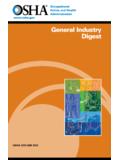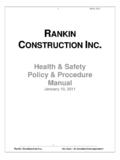Transcription of Occupational Safety and Health Guideline for …
1 UNITED STATES DEPARTMENT OF LABOR Home - Workers - Regulations - Enforcement - Data & Statistics - Training - Publications - Newsroom - Small Business Occupational Safety and Health Guideline for Carbon Monoxide DISCLAIMER: These guidelines were developed under contract using generally accepted secondary sources. The protocol used by the contractor for surveying these data sources was developed by the National Institute for Occupational Safety and Health (NIOSH), the Occupational Safety and Health Administration (OSHA), and the Department of Energy (DOE). The information contained in these guidelines is intended for reference purposes only.
2 None of the agencies have conducted a comprehensive check of the information and data contained in these sources. It provides a summary of information about chemicals that workers may be exposed to in their workplaces. The secondary sources used for supplements III and IV were published before 1992 and 1993, respectively, and for the remainder of the guidelines the secondary sources used were published before September 1996. This information may be superseded by new developments in the field of industrial hygiene. Therefore readers are advised to determine whether new information is available. Introduction This Guideline summarizes pertinent information about carbon monoxide for workers and employers as well as for physicians, industrial hygienists, and other Occupational Safety and Health professionals who may need such information to conduct effective Occupational Safety and Health programs.
3 Recommendations may be superseded by new developments in these fields; readers are therefore advised to regard these recommendations as general guidelines and to determine whether new information is available. Recognition SUBSTANCE IDENTIFICATION * Formula CO * Structure (For Structure, see paper copy) * Synonyms Coal gas, carbon oxide, carbonic oxide, exhaust gas, flue gas * Identifiers 1. CAS No.: 630-08-0 2. RTECS No.: FG3500000 3. DOT No.: UN 1016 18 (gas); NA 9202 67 (cryogenic liquid) 4. DOT label: Flammable gas, Poison gas (gas); Flammable gas (cryogenic liquid) * Appearance and odor Carbon monoxide is an odorless, colorless gas or, under high pressure, a liquid.
4 CHEMICAL AND PHYSICAL PROPERTIES * Physical data 1. Molecular weight: 2. Boiling point (at 760 mm Hg): degrees C ( degrees F) 3. Specific gravity (water = 1): at 0 degrees C (32 degrees F) 4. Vapor density: 5. Freezing point: -205 degrees C (-337 degrees F) 6. Vapor pressure at 20 degrees C (68 degrees F): Greater than 1 atmosphere (760 mm Hg) 7. Solubility: Sparingly soluble in water; soluble in ethanol, methanol, and some organic solvents. 8. Evaporation rate: Not applicable. * Reactivity 1. Conditions contributing to instability: Heat may cause containers of carbon monoxide to explode. 2. Incompatibilities: Contact of carbon monoxide with strong oxidizing agents, or halogen compounds causes a violent reaction.
5 3. Hazardous decomposition products: None reported. 4. Special precautions: None reported. * Flammability The National Fire Protection Association has assigned a flammability rating of 4 (severe fire hazard) to carbon monoxide. 1. Flash point: Not applicable. 2. Autoignition temperature: 609 degrees C (1128 degrees F) 3. Flammable limits in air (percent by volume): Lower, ; upper, 74 4. Extinguishant: Let a small fire burn unless the leak can be stopped immediately. Use water spray, fog, or regular foam to fight large fires involving carbon monoxide. Fires involving carbon monoxide should be fought upwind and from the maximum distance possible.
6 Keep unnecessary people away; isolate the hazard area and deny entry. Isolate the area for 1/2 mile in all directions if a tank, rail car, or tank truck is involved in the fire. For a massive fire in a cargo area, use unmanned hose holders or monitor nozzles; if this is impossible, withdraw from the area and let the fire burn. Emergency personnel should stay out of low areas and ventilate closed spaces before entering. Vapors may travel to a source of ignition and flash back. Vapors are an explosion and poison hazard indoors, outdoors, or in sewers. Containers of carbon monoxide may explode in the heat of the fire and should be moved from the fire area if it is possible to do so safely.
7 If this is not possible, cool fire-exposed containers from the sides with water until well after the fire is out. Stay away from the ends of containers. Personnel should withdraw immediately if a rising sound from a venting Safety device is heard or if there is discoloration of a container due to fire. Firefighters should wear a full set of protective clothing, including a self-contained breathing apparatus, when fighting fires involving carbon monoxide. EXPOSURE LIMITS * OSHA PEL The current Occupational Safety and Health Administration (OSHA) permissible exposure limit (PEL) for carbon monoxide is 50 parts per million (ppm) parts of air (55 milligrams per cubic meter (mg/m(3))) as an 8-hour time-weighted average (TWA) concentration [29 CFR Table Z-1].
8 * NIOSH REL The National Institute for Occupational Safety and Health (NIOSH) has established a recommended exposure limit (REL) for carbon monoxide of 35 ppm (40 mg/m(3)) as an 8-hour TWA and 200 ppm (229 mg/m(3)) as a ceiling [NIOSH 1992]. * ACGIH TLV The American Conference of Governmental Industrial Hygienists (ACGIH) has assigned carbon monoxide a threshold limit value (TLV) of 25 ppm (29 mg/m(3)) as a TWA for a normal 8-hour workday and a 40-hour workweek [ACGIH 1994, p. 15]. * Rationale for Limits The NIOSH limit is based on the risk of cardiovascular effects [NIOSH The ACGIH limit is based on the risk of elevated carboxyhemoglobin levels [ACGIH 1991, p.]]
9 229]. Evaluation Health HAZARD INFORMATION * Routes of Exposure Exposure to carbon monoxide can occur through inhalation of the gas and eye or skin contact with the liquid. * Summary of toxicology 1. Effects on Animals: Carbon monoxide is an asphyxiant that exerts its toxic effects by combining with the hemoglobin of the blood, which decreases the amount of oxygen delivered to the tissues. The LC(50) in rats is 1807 ppm for 4 hours [NIOSH 1993]. A carboxyhemoglobin level of 5 percent increases the degree of myocardial ischemia associated with acute myocardial infarction in dogs [ACGIH 1991]. Rhesus monkeys with severe carbon monoxide poisoning died as a result of lowered blood pressure and ventricular fibrillation [Gosselin Tolerance to the effects of carbon monoxide poisoning has been observed in chronically exposed animals [Gosselin 1984].
10 Laboratory animals exposed to carbon monoxide exhibit decreases in motor nerve conduction velocity and cellular changes in peripheral nerves[Gosselin 1984]. Carbon monoxide can be transported across the placental barrier. The offspring of pregnant rats exposed to 150 ppm carbon monoxide weighed less at birth, showed reduced growth rates, and performed poorly on negative geotaxis tests and homing tests [NLM Perinatal death occurred in 43 of 123 offspring of pregnant rabbits exposed to 180 ppm carbon monoxide, compared with one death in a non-exposed control group. Birth weights in the carbon monoxide- exposed animals averaged 10 grams less than those in non-exposed controls [NLM 1993].]





